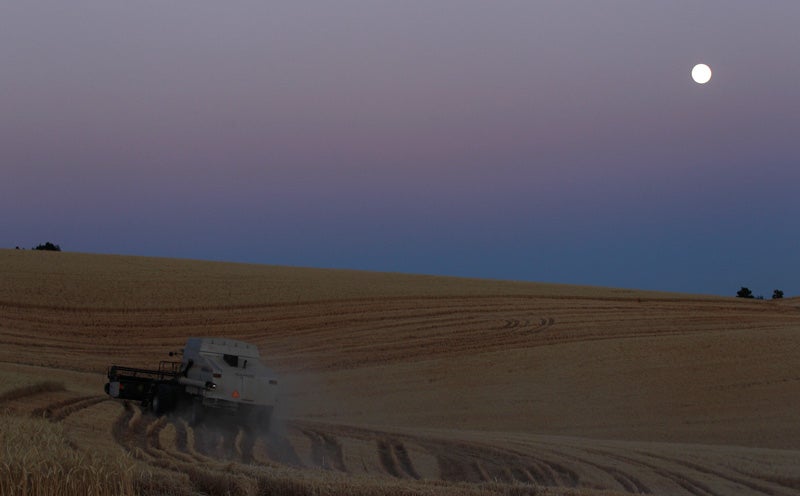Hooray for the Harvest Moon!
ListenWednesday’s full moon is this year’s Harvest Moon – way out ahead of Autumnal Equinox by 14 days. Next is Hunters’ Moon in October. Jupiter and Venus still have the pre-dawn sky in the East; Mars and Saturn still have the evening sky in the Southwest. Reminder that this season is a great time to look for satellites like ISS and others. Satellite Flybys from spaceweather.com or Satellite Safari from Southern Stars for your smartphone. And if binoculars are handy; under reasonably dark skies: check out a Globular cluster in Hercules, 25,000 light years away with several hundred thousand stars.
September 8, 2014
[Dave Heller] A full moon this week is but one of many treats available to be seen in the late summer night sky. Let’s head out of doors with Derrick Pitts, chief astronomer at the Franklin Institute. Derrick, what’s in a name?
[Derrick Pitts] All sorts of great things in a name. In fact, this Wednesday full moon will be the Harvest Moon for this year. This is one of the colloquial names, if you will, for the full moon of a month. In this case, the full moon of the autumnal equinox. Now it’s called the Harvest Moon because the way in which the moon rises right after sunset, the angle that the ecliptic makes on the horizon over successive days actually gives farmers extra light in the evening to harvest crops. The interesting thing about this full moon is that it comes about 14 days before the autumnal equinox. That’s a little unusual in that typically we expect it to come right around the autumnal equinox, or maybe a little bit later. But because of the way the orbital geometries go, it’s certainly possible for it to come this early. This also places the next full moon, the Hunter’s Moon of October, a bit earlier also, but all still within the same seasonal period so all is well.
-

Under a nearly full moon, Monte McMillan heads for home in his combine after spending the day cutting wheat on his farmland near Moscow, Idaho. (AP Photo/Ted S. Warren)
Now that bright full moon though may make it more of a challenge to view planets and other elements in the night sky this week.
Well, yes, probably for the other elements but not so for the planets because the planets can stand the brightness of the moon. And it turns out that we have great planet viewing possibilities at this time of this year. So for folks who are available in the evening right after sunset, we find around in the southwest that Saturn and Mars are sort of languishing there. They don’t seem to be heading down toward the western horizon very quickly, and in fact one of them is making its way back toward the east and its direct motion, Mars. And so the spacing between Saturn and Mars is growing quite quickly — you can watch that over the next several weeks. And if the evening sky is not the best time for you to observe planets, try the predawn sky. 5:45 to 6:15 or so in the morning, you’ll still be able to see Jupiter and Venus on the eastern horizons, nice and bright, easy to recognize without any difficulty at all. Jupiter’s the one that’s higher up on the eastern horizon, nice and bright before sunrise, and Venus is much lower on the horizon but would be much brighter if you have a clear view of the eastern horizon.
Now let’s bring man-made points of view into the mix.
Yeah — so this is a really great time to be viewing satellites in the evening sky or the predawn sky as well. Please remember that International Space Station is a great target because it’s bright and easy to see, but there are many other satellites that are visible int he evening sky if you just know where and when to look. Your smartphone can deliver all sorts of great information, and one of the programs that works really well on a phone is called Satellite Flybys, produced by spaceweather.com. And also Satellite Safari, created by Southern Skies, also works really well on your smartphone to show you what satellites will be available on a particular evening. Satellite Safari actually lets you do a little bit of forensic work and dig back in time to see what that satellite was that you saw the night before.
And this is all naked eye availability?
Yeah, absolutely. And that makes all of these objects easily available under urban night sky conditions.
Even better though if you have a pair of binoculars.
And if you can get just a little ways out of the bright sky conditions there are additional treats. There’s a really great globular cluster — a big ball of stars — in this case, several hundred thousand of them, located in the constellation Hercules. A good summer constellation almost directly overhead, a little bit to the west this time of the late summer. But with a pair of binoculars, you can easily see a fuzzy ball of stars, again, representing the several hundred thousand stars. One of the most interesting aspects is that if you can catch a glimpse of this, you’re actually observing 25,000 light years away to see this big ball of stars. It is one of a group of maybe 40 or 50 globular clusters that surround the Milky Way galaxy in space and is one of the oldest objects accompanying the galaxy in its motion through space.
-

Photo by Flickr user Jeffrey Sullivan
WHYY is your source for fact-based, in-depth journalism and information. As a nonprofit organization, we rely on financial support from readers like you. Please give today.




